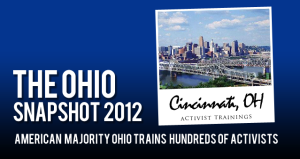Blog
The Ohio Snapshot 2012
February 28, 2013
In our trainings throughout Ohio in 2012, we focused primarily on “activist training”. Our office opened in Ohio shortly after the Super Tuesday primary in March, so the candidates were already set in place. As such, most of the hundreds of people we trained were interested in what they could do to help candidates win in their local areas.
- We emphasized a number of key points for activist success; organization, data, education, messaging, media, communication, and more.
- One of the most important overarching elements we discussed with trainees was the recommendation that individual activists need to start thinking long-term.
- By this we meant – whatever outreach you do for this or any election, make sure one of your goals is to build and grow a coalition that will last into the future.
One legitimate critique of political engagement on the “right” is that it has historically been too short term focused. Most right-leaning activist networks (if you can even call them that) get built around individual candidates and tend to collapse the day after the election whether the candidate wins or loses. The “left” operates differently by taking a longer-term approach. In Ohio, for example, to better assure their probability for success in 2012, the left never stopped organizing after 2008.
I have attended several activist meetings since the 2012 election in areas where we previously held trainings. I have seen “bring in more chairs” attendance at nearly every meeting. This is very good news! It means people got the message about staying together and building lasting local coalitions. They are still motivated – and, whether they realize it or not, they are also stronger.
Even though the top of the ticket outcome was not what many of them expected, they succeeded in building better relationships and better communication networks in their local communities. Keeping these coalitions intact will translate into more elective strength in the coming off-year elections and beyond. In Ohio, the 2013 contests are mainly school board, town/city council, and board of trustee type elections. These are all critical “pipeline” contests that can introduce greater numbers of principled, liberty-minded people to the political arena.
As grassroots coalitions engage in these winnable local races, they will build greater strength and momentum in their communities. In time, local elective success helps set the foundation for greater potency in larger contests. This is the type of citizen engagement that town-by-town, county-by-county, and state-by-state will ultimately help turn our country back in the right direction.

